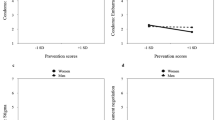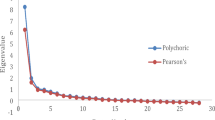Abstract
This study examined the impact of fear control and danger control messages on intentions to perform health behaviors. It was hypothesized that persons high in masculinity would be more influenced by messages that address fear than messages that exclusively focus on the efficacy of the behavior (danger control). To test this proposition, 172 participants were classified into high and low masculinity groups according to their scores on the Bem Sex Role Inventory, and randomly assigned fear reducing or danger control messages either encouraging detection behavior (skin cancer self-examination) or promotion behavior (sunscreen usage). Highly masculine participants demonstrated greater behavioral intentions and more positive attitudes about the behavior when exposed to a fear-reducing message. The results suggest that it is possible to motivate adaptive health behavior even when a person is engaging in fear control.


Similar content being viewed by others
Notes
Three participants failed to complete one of the behavioral intention scales and were not included in this analysis.
One participant failed to complete one of the effectiveness scales and was not included in this analysis.
References
Bailis, D., Fleming, J., & Segall, A. (2005). Self-determination and functional persuasion to encourage physical activity. Psychology & Health, 20, 691–708.
Bem, S. L. (1974). The measurement of psychological androgyny. Journal of Consulting and Clinical Psychology, 42, 155–162.
Bem, S. L. (1978). The short Bem sex role inventory. Palo Alto, CA: Consulting Psychologists Press.
Bem, S. L. (1981). Gender schema theory: A cognitive account of sex typing. Psychological Review, 88, 354–364.
Cacioppo, J. T., & Petty, R. E. (1982). The need for cognition. Journal of Personality and Social Psychology, 42, 116–131.
Clary, E., Snyder, M., Ridge, R., Miene, P., & Haugen, J. (1994). Matching messages to motives in persuasion: A functional approach to promoting volunteerism. Journal of Applied Social Psychology, 24, 1129–1149.
Conway, M., DiFazio, R., & Bonneville, F. (1991). Sex, sex roles, and response styles for negative affect: Selectivity in a free recall task. Sex Roles, 25, 687–700.
Conway, M., & Dube, L. (2002). Humor in persuasion on threatening topics: Effectiveness is a function of audience sex role orientation. Personality and Social Psychology Bulletin, 28, 863–873.
Conway, M., Giannopoulos, C., & Stiefenhofer, K. (1990). Response styles to sadness are related to sex and sex-role orientation. Sex Roles, 22, 579–587.
Costa, P. J. Jr., & McCrae, R. R. (1985). The NEO personality inventory manual. Odessa, FL: Psychological Assessment Resources.
Cramer, K., & Neyedley, K. (1998). Sex differences in loneliness: The role of masculinity and femininity. Sex Roles, 38, 645–653.
Erblich, J., Bovbjerg, D., & Valdimarsdottir, H. (2000). Psychological distress, health beliefs, and frequency of breast self-examination. Journal of Behavioral Medicine, 23, 277–292.
Gore, T., & Campanella, B. (2005). Testing the theoretical design of a health risk message: Reexamining the major tenets of the Extended Parallel Process Model. Health Education & Behavior, 32, 27–41.
Jakupcak, T., & Roemer, L. (2005). Masculinity, shame, and fear of emotions as predictors of men’s expressions of anger and hostility. Psychology of Men & Masculinity, 6, 275–284.
Jansz, J. (2000). Masculine identity and restrictive emotionality. In A. Fischer (Ed.), Gender and emotion: Social psychological perspectives (pp. 166–186). New York: Cambridge University Press.
Janz, N. K., & Becker, M. H. (1984). The health belief model: A decade later. Health Education Quarterly, 11, 1–47.
Kaplan, M. S., & Marks, G. (1995) Appraisal of health risks: The roles of masculinity, femininity, and sex. Sociology of Health and Illness, 17, 206–218.
Lerman, C., Trock, B., Rimer, B., Jepson, C., Brody, D., & Boyce, A. (1991). Psychological side effects of breast cancer screening. Health Psychology, 10, 259–267.
Leventhal, H. (1970). Findings and theory in the study of fear communications. In L. Berkowitz (Ed.), Advances in experimental social psychology, Vol. 5 (pp. 119–186). New York: Academic Press.
McKay, D., Berkowitz, J., & Blumberg, J. (2004). Risk due to elevated homocysteine levels: Using the EPPM to develop print materials. Health Education & Behavior, 31, 355–371.
Meyer, C., Blissett, J., & Oldfield, C. (2001). Sexual orientation and eating psychopathology: The role of masculinity and femininity. International Journal of Eating Disorders, 29, 314–318.
Millar, M. G. (2004). Effects of activities analysis and reasons analysis on intentions to perform health promotion and disease detection behaviors. Journal of Applied Social Psychology, 34, 1–14.
Millar, M. G. (2005). The effects of stress on reactions to messages designed to increase health behaviors. Journal of Behavioral Medicine, 23, 1–8.
Millar, M. G., & Millar, K. (1996). The effects of anxiety on response times to disease detection and health promotion behaviors. Journal of Behavioral Medicine, 21, 401–413.
Murray-Johnson, L., Witte, K., & Patel, D. (2004). Using the Extended Parallel Process Model to prevent noise-induced hearing loss among coal miners in Appalachia. Health Education & Behavior, 31, 741–755.
Murray, M., & McMillan, C. (1993). Health beliefs, locus of control, emotional control and women’s cancer screening behaviour. British Journal of Clinical Psychology, 32, 87–100.
Oliver, S., & Toner, B. (1990). The influence of gender role typing on the expression of depressive symptoms. Sex Roles, 22, 775–790.
Petty, R. E., & Wegener, D. T. (1998). Matching versus mismatching attitude functions: Implications for scrutiny of persuasive messages. Personality and Social Psychology Bulletin, 24, 227–240.
Pollack, W. S. (1999). The sacrifice of Isaac: A new psychology of boys and men. Society for the Psychological Study of Men and Masculinity Bulletin, 4, 7–14.
Radley, A., Grove, A., Wright, S., & Thurston, H. (2000). Gender-role identity after heart attack: Links with sex and subjective health status. Psychology & Health, 15, 328–335.
Rogers, R. W. (1983). Cognitive and physiological processes in fear appeals and attitude change: A revised theory of protection motivation. In J. Cacioppo & R. E. Petty (Eds.), Social psychophysiology (pp. 153–176). New York: Guilford Press.
Rosenstock, I. M. (1974). Historical origins of the health belief model. Health Education Monographs, 2, 328–335.
Rotter, J. B. (1954). Social learning and clinical psychology. New York: Prentice-Hall.
Ruiter, R. A. C., Abraham, C., & Kok, G. (2001). Scary warnings and rational precautions: A review of the psychology of fear appeals. Psychology and Health, 16, 613–630.
Ruiter, R., Verplanken, B., De Cremer, D., & Kok, G. (2004). Danger and fear control in response to fear appeals: The role of need for cognition. Basic and Applied Social Psychology, 26, 13–24.
Saraiya, M., Glanz, K., Briss, P. A., Nichols, P., White, C., & Das, D. (2004). Interventions to prevent skin cancer by reducing exposure to ultraviolet radiation: A systematic review. American Journal of Preventive Medicine, 27, 422–466.
Simons, J., & Gaher, R. (2005). The distress tolerance scale: Development and validation of a self-report measure. Motivation and Emotion, 29, 183–102.
Twenge, J. (1997). Changes in masculine and feminine traits over time: A meta-analysis. Sex Roles, 36, 305–325.
Walters, G. (2001). The relationship between masculinity, femininity, and criminal thinking in male and female offenders. Sex Roles, 45, 677–689.
Williams-Piehota, P., Schneider, T., Pizarro, J. (2004). Matching health messages to health locus of control beliefs for promoting mammography utilization. Psychology & Health, 19, 407–423.
Witte, K. (1992). Putting the fear back into fear appeals: The extended parallel process model. Communication Monographs, 59, 329–349.
Witte, K. (1994). Fear control and danger control: A test of the extended parallel process model (EPPM). Communication Monographs, 61, 113–134.
Witte, K., & Allen, M. (2000). A meta-analysis of fear appeals: Implications for effective public health campaigns. Health Education & Behavior, 27, 591–615.
Author information
Authors and Affiliations
Corresponding author
Rights and permissions
About this article
Cite this article
Millar, M.G., Houska, J.A. Masculinity and Intentions to Perform Health Behaviors: The Effectiveness of Fear Control Arguments. J Behav Med 30, 403–409 (2007). https://doi.org/10.1007/s10865-007-9113-8
Received:
Accepted:
Published:
Issue Date:
DOI: https://doi.org/10.1007/s10865-007-9113-8




